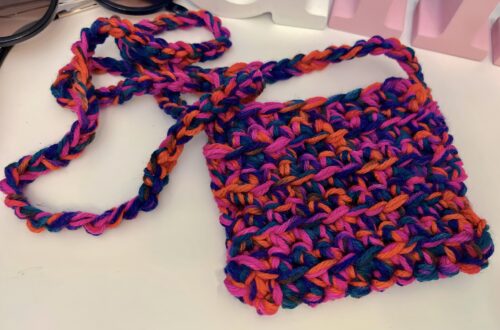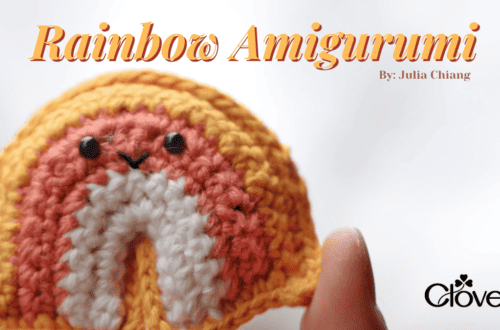Do’s & Don’ts: Amigurumi for Beginners
Amigurumi Do’s & Don’ts
Hi everyone! I’m Julia, the designer over at Little World of Whimsy. I spend most of my free time crocheting amigurumi, after beginning my journey over a year ago, so I’m here to share some of my do’s and don’ts for amigurumi beginners!
Let’s start with some of the do’s:
Do use stitch markers!
Although stitch markers are always important when crocheting, they are paramount in amigurumi. This is mainly because amigurumi are always crocheted in continuous, spiral rounds, which are absolutely impossible to keep track of without stitch markers.
I love Clover’s quick locking stitch markers because they don’t slip out and are easy to secure, and I usually place them in the last stitch of each round. That way, I know exactly where each round begins and ends. This is incredibly helpful so that you don’t find yourself frogging the entire project whenever you miscount!

Do size down your hook to avoid holes!
A signature characteristic of amigurumi is that the crochet fabric is always extremely dense, without any holes. This is because amigurumi are crochet toys, and are always stuffed with polyfil or other types of stuffing. The crochet fabric must be dense and tight to prevent stuffing from coming out, and also so that it feels sturdy to play with.
When making amigurumi, size down your hook one or two sizes down what the yarn label instructs you to use. I usually use 3.25mm hooks for sport weight yarn and 3.5mm for worsted weight, but I know others prefer 3.0mm or even 2.5mm for sport weight yarn!

Do use safety eyes!
If you’re confused about how to create eyes on your amigurumi, this is the secret. Safety eyes are plastic, round, black eye pieces that look like screws with a smooth head. They always come with a plastic washer that fits over the back to secure it in place on the crochet fabric.
Use safety eyes to effortlessly turn your crochet stuffies into charming characters! However, do note that although safety eyes sound like they are child safe, they aren’t, given that it’s possible to pull the safety eye out of the washer. For small children, I recommend you to embroider eyes or glue felt circles on instead.

Do stuff firmly.
No matter what type of stuffing you use, make sure that you stuff each amigurumi piece firmly, by breaking up the stuffing into pieces and pushing it in a little at a time. Stuff each component until it feels firm from the outside and without much give.
Although when you first get started making amigurumi it may be tempting to stuff loosely so that your amigurumi will be more squishy, rest assured that even if you stuff firmly your amigurumi will still be soft and malleable. The danger in not stuffing firmly is that after you finish, your amigurumi will not maintain the shape that you painstakingly created.
Do use cotton yarn.
This one is more optional, but I recommend amigurumi beginners to begin by using cotton yarn for their amigurumi. Scheepjes Catona and Paintbox Cotton Aran are both great options with a large color palette.
Cotton yarn is ideal for beginners because it has extremely good stitch definition, meaning it’s much easier to see where your stitches are. This can be really helpful when you need to count your stitches carefully and place the increase just so. Once you feel confident with cotton, feel free to move onto acrylic, alpaca, velvet, and even faux fur!

Now let’s go over the don’ts!
Don’t tackle a complex project on your first try.
If you’re just getting started on your amigurumi journey, don’t try to take on more than you can chew. For beginners, I recommend ball-shaped amigurumi without many extra limbs, so that you don’t have to get bogged down making too many extra pieces. Also, crocheting is relatively time consuming, so it’s awesome to have a quick win to get you motivated to tackle bigger projects!
I suggest that for each project you take on, zero in on one specific skill or technique that you want to learn with that project. Don’t try a project that has lots of new components that you need to master all at once. I find that one new technique is the sweet spot that will keep things challenging but also keep you moving along!

I made a small narwhal like this one (pattern available on Clover’s blog) for my first project!
Don’t crochet if your wrists are in pain.
Crocheting amigurumi means that you’ll have an extremely tight tension, especially since you’re working with a smaller hook size. Because of this, it’s easier to feel pain in your fingers and wrists.
If the hand holding the hook hurts, I highly recommend upgrading to Clover Amour hooks, because they are much easier on your hands and glide through yarn very well.
However, in any case, long hours spent crocheting amigurumi every day can result in permanent damage, so make sure to take a break and absolutely do not push through pain.
Crocheting while stressed can also aggravate this, so try to plan out your crocheting beforehand, especially if you anticipate a busy gift season!

Don’t give up!
Crocheting amigurumi can take a few projects to get the hang of, but once you have those under your belt, you’ll be flying. Don’t give up if your first project doesn’t turn out the way you want or the crochet hook feels awkward in your hand.
I thought crocheting felt so unnatural the first few times that I attempted it, but after a while, it came much more easily. Don’t give up!



